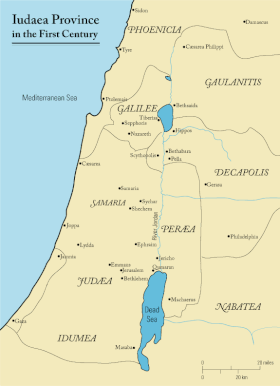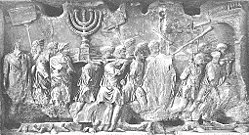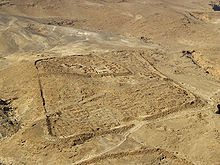This is an old revision of this page, as edited by Avenue (talk | contribs) at 01:11, 2 April 2008 (→The outcome: Fix open <ref>). The present address (URL) is a permanent link to this revision, which may differ significantly from the current revision.
Revision as of 01:11, 2 April 2008 by Avenue (talk | contribs) (→The outcome: Fix open <ref>)(diff) ← Previous revision | Latest revision (diff) | Newer revision → (diff)| First Jewish-Roman War | |||||||
|---|---|---|---|---|---|---|---|
| Part of Jewish-Roman wars | |||||||
 Judea in the first century | |||||||
| |||||||
| Belligerents | |||||||
| Roman Empire | Jews of Iudaea Province | ||||||
| Commanders and leaders | |||||||
|
Vespasian, Titus |
Simon Bar-Giora, Yohanan mi-Gush Halav (John of Gischala), Eleazar ben Simon | ||||||
| Strength | |||||||
| 70,000? | 1,100,000? | ||||||
| Casualties and losses | |||||||
| Unknown | Unknown, but many civilian casualties | ||||||
| Jewish–Roman wars | |
|---|---|
Prelude
Major conflicts |
| First Jewish–Roman War | |||||||||||
|---|---|---|---|---|---|---|---|---|---|---|---|
| |||||||||||
The first Jewish-Roman War (years 66–73 CE), sometimes called The Great Revolt (Template:Lang-he, ha-Mered Ha-Gadol), was the first of three major rebellions by the Jews of Iudaea Province against the Roman Empire (the second was the Kitos War in 115–117 CE, the third was Bar Kokhba's revolt, 132–135 CE). It began in the year 66, stemming from Greek and Jewish religious tension. It ended when legions under Titus besieged and destroyed Jerusalem, looted and burned Herod's Temple (in the year 70) and Jewish strongholds (notably Gamla in 67 and Masada in 73), and enslaved or massacred a large part of the Jewish population.
The defeat of the Jewish revolts by the Roman Empire contributed substantially to the numbers and geography of the Jewish diaspora, as many Jews were scattered or sold into slavery after losing their state.
Background
In the year 6 AD, Judaea, which had been a client kingdom of Rome (i.e., it had its own ruler), became a Roman province ruled by a Roman procurator, who was responsible for maintaining peace and collecting taxes. Pocketing any amount above the quota had been a regular practice, which led to abuse. Tensions rose when Rome took over the appointment of the High Priest, also beginning about the year 6. In 39 AD, Emperor Caligula declared himself a god and ordered his statues to be set up in temples throughout the Empire. The Jews refused, and began preparations for armed revolt. The theft of a large amount of money from the Temple treasury by procurator Gessius Florus (who, according to Tacitus, "indulged in every kind of robbery and violence") contributed to the radicalization and increased the popularity of Zealots, some of whom believed that any means were justified in order to attain political and religious independence from Rome.
First Jewish successes
The revolt began in 66 in Caesarea, provoked by Greeks sacrificing birds in front of a local synagogue. The Greek-speaking Roman garrison did not intercede. In an act of defiance, the son of Kohen Gadol (High priest) Eliezar ben Hanania ceased prayers and sacrifices for the Roman Emperor at the Temple and subsequently led a successful attack on the Roman garrison stationed in Jerusalem. The pro-Roman king Agrippa II and his sister Berenice fled Jerusalem to Galilee, where later they gave themselves up to the Romans. Cestius Gallus, the legate of Syria, brought reinforcements to restore order, but was soundly defeated at the Battle of Beth Horon. While retreating, Legio XII Fulminata even lost its aquila.
The fall
Emperor Nero appointed general Vespasian instead of Gallus to crush the rebellion. Vespasian made Caesarea Maritima his headquarters and with his legions — among them X Fretensis and V Macedonica, 60,000 professional soldiers — methodically cleared the coast and the North. Some towns gave up without a fight. By the year 68, Jewish resistance in the North had been crushed.
The leaders of the collapsed Northern revolt, John of Giscala and Simon Bar Giora, managed to escape to Jerusalem. Brutal civil war erupted: the Zealots and Sicarii executed anyone advocating surrender, and by 68 the entire leadership of the southern revolt was dead, all killed by the Jews, none by the Romans.
After the death of Nero and with the backing of the army, Vespasian was proclaimed emperor in 69 and left for Rome to take the throne from Vitellius in a brief Roman civil war, the so-called Year of the four emperors.
The fall of Jerusalem
Main article: Siege of Jerusalem (70)The siege of Jerusalem, the capital city, had begun early in the war, but had turned into a stalemate. Unable to breach the city's defenses, the Roman armies established a permanent camp just outside the city, digging a trench around the circumference of its walls and building a wall as high as the city walls themselves around Jerusalem. Anyone caught in the trench attempting to flee the city would be captured, crucified, and placed in lines on top of the dirt wall facing into Jerusalem.The two Zealot leaders, John of Gischala and Simon Bar Giora only ceased hostilities and joined forces to defend the city when the Romans began to construct ramparts for the siege. Tens of thousands of crucified bodies encircled Jerusalem by the end of the siege.
Titus Flavius, Vespasian's son, led the final assault and siege of Jerusalem. During the infighting inside the city walls, a stockpiled supply of dry food was intentionally burned by Jewish leaders to induce the defenders to fight against the siege instead of negotiating peace; as a result many city dwellers and soldiers died of starvation during the siege. Zealots under Eleazar ben Simon held the Temple, Sicarii led by Simon Bar Giora held the upper city. Titus eventually wiped out the last remnants of Jewish resistance. He was so determined that nearly three years after the destruction of Jerusalem he was still hunting down rebellious Jews, including a determined band that held the mountain fortress Masada.

By the summer of 70, the Romans had breached the walls of Jerusalem, ransacking and burning nearly the entire city. The Romans began by attacking the weakest spot which was the third wall. It was built shortly before the siege so it did not have as much time invested in its protection. They succeeded towards the end of May and shortly afterwards broke through the more important second wall. The Second Temple was destroyed on Tisha B'Av (July 29 or July 30), 70. Tacitus, a historian of the time, notes that those who were besieged in Jerusalem amounted to no fewer than six hundred thousand, that men and women alike and every age engaged in armed resistance, everyone who could pick up a weapon did, both sexes showed equal determination, preferring death to a life that involved expulsion from their country. All three walls were destroyed and in turn so was the Temple. John of Giscala surrendered at Agrippa II's fortress of Jotaphta and was sentenced to life imprisonment. The famous Arch of Titus still stands in Rome: it depicts Roman legionaries carrying off the Temple of Jerusalem's treasuries, including the menorah.
The fall of Masada
Main article: Masada
During the spring of 71, Titus set sail for Rome. A new military governor was then appointed from Rome, Lucilius Bassus, whose assigned task was to undertake the "mopping-up" operations in Judaea. He used X Fretensis to oppose the few remaining fortresses that still resisted. Bassus took Herodium, and then crossed the Jordan to capture the fortress of Machaerus on the shore of the Dead Sea. Due to illness, Bassus did not live to complete his mission. Lucius Flavius Silva replaced him, and moved against the last Jewish stronghold, Masada, in the autumn of 72. He used Legio X, auxiliary troops, and thousands of Jewish prisoners, for a total of 10,000 soldiers. After his orders for surrender were rejected, Silva established several base camps and circumvallated the fortress. According to Josephus, when the Romans finally broke through the walls of this citadel in 73, they discovered that the 967 defenders had preferred death, than to be tortured by the Romans. Since suicide was not allowed by the Jewish religion, they killed each other till the last man, who was the only one who had to commit suicide.
The outcome
Josephus claims that 1,100,000 people were killed during the siege, of which a majority were Jewish. 97,000 were captured and enslaved. Many fled to areas around the Mediterranean.
The Romans hunted down and slaughtered entire clans, such as descendants of the House of David. On one occasion, Titus condemned 2,500 Jews to fight with wild beasts in the amphitheatre of Caesarea in celebration of his brother Domitian's birthday.


Vespasian died of an infection on June 23 79 AD,
The Jewish Encyclopedia article on the Hebrew Alphabet states: "Not until the revolts against Nero and against Hadrian did the Jews return to the use of the old Hebrew script on their coins, which they did from similar motives to those which had governed them two or three centuries previously; both times, it is true, only for a brief period."
Titus reportedly refused to accept a wreath of victory, as there is "no merit in vanquishing people forsaken by their own God".
Before Vespasian's departure, the Pharisaic sage and Rabbi Yohanan ben Zakkai obtained his permission to establish a Judaic school at Yavne. Zakkai was smuggled away from Jerusalem in a coffin by his students. Later this school has become a major center of Talmudic study. (See Mishnah)
Sources
The main account of the revolt comes from Josephus, the former Jewish commander of Galilee who switched over to the Roman side. Josephus had been granted citizenship and a pension in Rome and was well accepted at the courts of Vespasian, Titus and Domitian.
His popular works The Wars of the Jews (c. 79) and Jewish Antiquities (c. 94) — especially its autobiographical appendix — are frequently contradictory. He was loathed by the Jews as a turncoat and Roman apologist and never returned to his homeland after the fall of Jerusalem, enjoying his life to the full in Rome.
References
- Josephus, War of the Jews II.8.11, II.13.7, II.14.4, II.14.5
- Josephus, War of the Jews II.14.5
- "Jews, God and History" by Max I. Dimont
- The Masada Myth, Nachman Ben-Yehuda, Hebrew University, Retrieved July 7 2006
- Josephus, War of the Jews VI.9.3
- Josephus, War of the Jews VI.9.3
- Cassius Dio, Roman History
- Alphabet, the Hebrew. Coins, and Bibliography 6
- Philostratus, Vita Apollonii
See also
- Josephus and his works at Gutenberg
- Tacitus
- Timeline of Jewish History
- History of ancient Israel and Judah
- Israel and History of Israel
- Judea
Template:Link FA Template:Link FA
Categories: